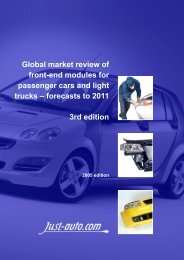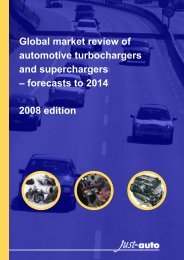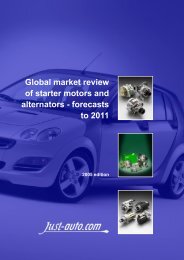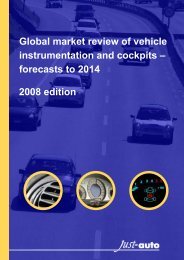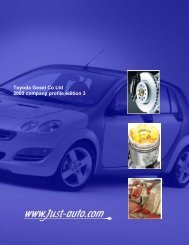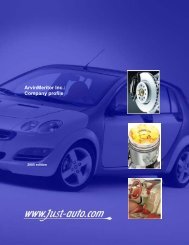A global market review of automotive steering systems - Just-Auto.com
A global market review of automotive steering systems - Just-Auto.com
A global market review of automotive steering systems - Just-Auto.com
You also want an ePaper? Increase the reach of your titles
YUMPU automatically turns print PDFs into web optimized ePapers that Google loves.
Chapter 2 The <strong>market</strong> Page 5<br />
Chapter 2 The <strong>market</strong><br />
Market trends<br />
During the last decade or so there has been a slow evolution in power <strong>steering</strong><br />
but recent engine-independent EHPS and EPS have marked a major change<br />
in the technology. While EPS and EHPS have made inroads in Europe and<br />
Japan, American vehicle makers have been reluctant to replace their proven<br />
hydraulic <strong>systems</strong> with the more costly electric ones because they claim the<br />
benefits are largely unnoticeable and the added cost unjustifiable to<br />
customers. EPS <strong>systems</strong> began to appear in the late 1980s, initially in mini<br />
cars. The key benefit <strong>of</strong> EPS is in the increased fuel efficiency obtained by<br />
freeing the engine from powering the <strong>steering</strong> <strong>com</strong>pressor, and demand would<br />
probably be far higher if fuel prices in the US and Japan were as high as they<br />
are in the UK and Germany, for example, where the fuel savings <strong>of</strong> EPS have<br />
sufficient impact to <strong>of</strong>fset the added cost <strong>of</strong> the system.<br />
With regard to power <strong>steering</strong>, there has been a transition from hydraulic to<br />
more environmentally-friendly electronic control <strong>systems</strong>, (hydraulic power<br />
<strong>steering</strong> involves excess pumping, whereas electric power <strong>steering</strong> uses less<br />
energy and is also lighter and more <strong>com</strong>pact). The diffusion <strong>of</strong> electric power<br />
<strong>steering</strong> is led by Europe, with its strict environmental regulations, as well as<br />
by Japan, where small cars are <strong>com</strong>mon.<br />
Electrically power-assisted <strong>steering</strong> <strong>systems</strong> are headed for the mass-<strong>market</strong><br />
worldwide, helped by their potential to save manufacturers money, reduce<br />
customers’ fuel bills, save designers valuable space, and possibly save lives<br />
as well. TRW believes switching to electric can save vehicle makers $5-10 per<br />
car, because the units are quicker to install, eliminate <strong>com</strong>plex set-up<br />
engineering and have fewer moving parts. TRW’s EPHS module is fully filled<br />
with hydraulic fluid and takes GM about 30 seconds to install and connect the<br />
module to the vehicle’s electrical system. Delphi estimates its own system cuts<br />
four minutes <strong>of</strong>f the assembly time <strong>of</strong> a vehicle and reduces <strong>com</strong>ponent parts<br />
stocked from 15 to only two. Delphi also believes that its system can deliver<br />
fuel savings <strong>of</strong> 0.21 to 0.41 kilometres per 100km, because it draws less power<br />
from the engine. Electric <strong>steering</strong> could also be safer, as it still works if the<br />
engine stalls, unlike hydraulic <strong>systems</strong>.<br />
© 2004 All content copyright Aroq Ltd. All rights reserved.




